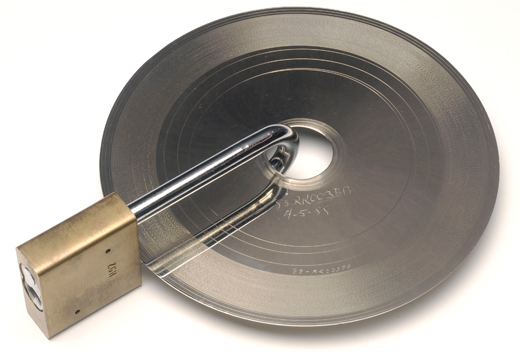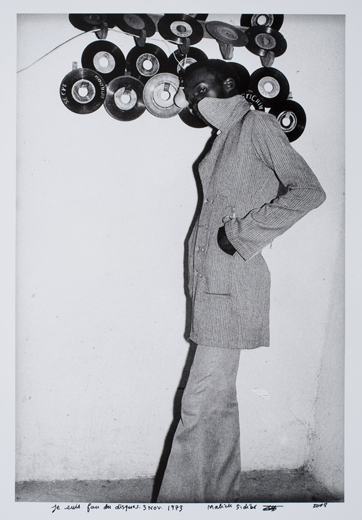THE RECORD
Jay Hines, Mingering Mike & Trevor Schoonmaker in conversation with Nicolas Lobo

Christian Marclay, “Secret,” 1988. Photo by Peter Paul Geoffrion, courtesy of the artist and Paula Cooper Gallery, New York.
On the occasion of The Record: Contemporary Art and Vinyl, a traveling exhibition originating at the Nasher Museum of Art and currently on view at the Miami Art Museum, where it was organized by Rene Morales, artist Nicolas Lobo discusses the intersection of objects, sound and history with artist and audiophile Jay Hines, fictitious funk and soul recording artist Mingering Mike and the show’s curator Trevor Schoonmaker.
Jay Hines
Miami Rail (Nicolas Lobo) Your band projects bleed into your sound projects, which melt into your drawings, sculptures, etc. Are you making conscious connections between the formats you use or just operating on intuition until something sticks?
JH Intuition mostly.
MR Why did you choose the cassette tape format to put out multiples by artists on your label Augurari?
JH Doing small editions in an obsolete (from a larger commercial perspective) media format allows for a particular “object fetish” which mimes the DIY music aesthetic and the heralded lowbrow collector of cult oddities type of thing… I love the idea that some people who own a tape, who’ve sought it out due to their interest in a particular artist’s work, may never actually play it because they don’t have a cassette player.
MR How important is some version of nostalgia in your work as an artist?
JH It seems like nostalgia is a symptom now. It’s like the answer to quickly changing cultural interests or trends, both populist and niche concerns. At best, nostalgia assists in codifying one’s present position through personal “total recall.” At worst, it isolates via xenophobic opposition. Nostalgia is a simulacrum that denies the actual and the present. There’s a fine line in art between modulating an idea or perception in the name of exploration and simply striving to archive and edify the world in an idiosyncratic way. So yes, nostalgia is important to me as an artist, but only in the fascist/moralistic sense (not really).
MR What if Sony put out the Walkman again?
JH That would be a failed attempt to make money on Sony’s part. I’d look into the untapped techniques of sound transcriptions on one-off Risograph prints by visual artists who don’t use sound in their work.
Mingering Mike
MR Are you working on any new records right now?
MM Yeah… I’m working on another album titled The Land of Opportunity.
MR Is this your first project in a while or have you been keeping up with the work all along?
MM I’ve been keeping up with the work as inspiration hits me, but this is the first gatefold album I’ve done in thirty years or so.
MR Is there a major break in the subject matter this time around?
MM Well it’s the same type of feeling, inspiration and thought. This is a new era, but some things go in cycles. I’m talking about things people are used to, things people accept, things people protest about, things that should be changed. It’s about the same thing at a different time.
MR What was stopping you in the ’70s from actually pressing a record?
MM It wasn’t available to me and I didn’t want to take chances on those ads promising you this and that and next thing you know all they’re doing is taking your money. I decided, if music is something that’s going to stick with me I’ll continue making a living and keep the music going at the same time in case anything comes of it. After years of struggling like everyone trying to pay the bills, suddenly Dori [Hadar, Mike’s original fan and confidante] entered the picture and I had a resurgence of thought and feelings about pursuing music again.
MR Having a record pressed was not as important to you as undertaking a music career?
MM I didn’t want to lose my train of thought. If I had words to a song or a way to arrange musical instruments I put it on tape, that way I could remember how things went together. I wanted to document everything so if there was an opportunity to pursue it deeply I would be ready.
MR So your tape recordings are sketches of future songs?
MM Well it’s fifty-fifty because I wasn’t quite satisfied with some things that I’ve done but I had it recorded so I could make changes later.
MR Because you’re from D.C. I wanted to ask if you’ve ever been involved with the Go-go scene.
MM I’m not really a fan. Most of the time with Go-go it’s about just having fun and I wanted to have a wide range of emotions and thoughts in what I was doing because life isn’t always, as they say, a bowl of cherries.
Many of Mingering Mike’s original recordings can be downloaded at emusic.com
Trevor schoonmaker
MR What comes to mind when you consider a vinyl record?
TS I enjoy the warm sound of records, but I’m primarily interested in the way that records speak to identity, culture and history. I also love records as aesthetic objects — their shape, material, scale, cover art, gatefold, liner notes, poster inserts, etc.
MR The vinyl record has been fetishized over the phonograph. At the same time, the cassette boombox has become iconic rather than the cassette itself. Do you think this is related to shifting industrial design sensibilities?

Malick Sidibé, “Je Suis Fan des Disques, 3 Nov. 1973 (I Am a Fan of Records),” 1973–2008. Courtesy of the artist and Jack Shainman Gallery, New York.
TS I’m not interested in fetishizing records, but in terms of design, it’s hard to top the beautiful simplicity of a round flat disk, or the 12–inch square album cover. The boombox is a striking object that became synonymous with hip-hop culture in the 80s, so it’s become more iconic than the cassette tape, which is equally associated with the Walkman.
MR What interests you in artists using a technologically obsolete format as opposed to a cutting edge means of mass distribution?
TS I don’t think of records as obsolete. New vinyl is being produced by young bands, many DJs only spin vinyl, and record sales are rising within albeit a niche market. MP3s are very practical because they are easily played, stored and shared, but they are also invisible and formless, so there’s little appeal to them otherwise. What does it mean to see someone‘s MP3 collection? Not much.
MR Are you seeing the continued popularity of vinyl records as a disturbance in the idea of technological progress?
TS Today things are increasingly fast-paced, mass-produced and ephemeral, so, many people are looking for something more tangible, personal, and “authentic,” which records provide. I liken the renewed interest in records to the simultaneous rise of the Slow Food movement
MR Do artworks that rely on nostalgia present difficulties as they age, where the nostalgia for 10 years prior can become insignificant after 50 or 100 years?
TS It’s great that more people are embracing records, but the artists in the exhibition are not driven by nostalgia and this exhibition isn’t about nostalgia. Many works in the show were produced when records were cutting edge technology and the exhibition demonstrates how visual artists for more than 50 years have never stopped being inspired by vinyl records. They remain significant as cultural and historical signifiers, markers of identity, and repositories for sound.










